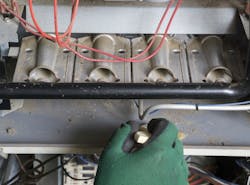Buildings can be places of work, learning, healing, vacationing and more. Proper building maintenance helps ensure that residents, customers, patients and other people remain healthy and safe while inside. One of the most important ways a building can achieve their goals while protecting occupant health is to promote optimal indoor air quality (IAQ).
To help curb the spread of respiratory illness, control odor and improve overall IAQ, ventilation must be treated as an integral component of building maintenance. Implementing regular air conditioning (A/C) deep cleanings is the best way to face the challenges associated with poor IAQ.
It’s important for building managers to understand how these processes work and when to conduct them to reduce the negative impact of poor IAQ on building occupants and the bottom line.
Health and IAQ
The design and continued maintenance of buildings are integral to the health of their inhabitants. Low IAQ and poor ventilation have been shown to result in immediate health effects, including irritation of the eyes, nose, and throat, headaches, dizziness, and fatigue. While some effects are short-term and treatable, others may show up years later or following long periods of exposure.
[More on Sick Building Syndrome]
Long-term effects, which include some respiratory diseases, heart disease and cancer, can be severely debilitating or fatal. Even if symptoms are not noticeable right away, proactively working to provide the best quality indoor air can help lower these risks.
Studies also indicate that poor indoor air quality in buildings can decrease productivity, in addition to causing visitors to express dissatisfaction. Estimates of performance losses from poor IAQ for all buildings suggest a 2 to 4 percent loss on average.
Related unpleasant odors and physical symptoms like coughing or sneezing cause discomfort and are easily preventable. Clean air supports the health of building occupants, helping employees perform at their best.
Facility managers should be aware of the possible sources of poor air quality and have the resources necessary to recognize and control these hazards. In addition to conducting a building walkthrough to identify any questionable odors, temperature changes or signs of asbestos, facility supervisors should conduct regular checks on the building’s A/C system.
[Related: The Terrifying Resurfacing of Asbestos]
Benefits of Deep Cleaning
Facility managers should schedule regular deep cleanings for A/C systems, as most managers clean some parts of a unit like the base pan or coil more often than the entire unit. Deep cleanings are important for making sure the entire unit is clear of contaminants and operating at peak efficiency.
A/C unit deep cleaning provides several benefits, including:
- Improved IAQ. A clean air filter with clean coils can effectively reduce allergens, particles and other debris from the air. This also results in better air flow to provide maximum comfort to building occupants.
- Minimized odors. If left unchecked, odors can overtake a room’s ambiance and cause discomfort for students and staff. By deep cleaning and sanitizing an A/C unit, facility managers can kill odor-causing bacteria, mold and mildew.
- Lower energy consumption. Most energy in commercial buildings is used by lighting and HVAC (heating, ventilation and air conditioning). Thoroughly and regularly cleaned units transfer air more quickly and efficiently, reducing the amount of energy consumed.
- Longer unit life expectancy. A/C units are expensive to replace, and neglecting their care can lead to increased expenditures. Deep cleaning helps maximize an A/C unit’s life expectancy to reduce long-term costs.
A Breath of Fresh Air
Facility managers are responsible for maintaining the health and safety of their occupants. Indoor air quality can play a major role in employee performance and satisfaction, making tasks like regular A/C unit deep cleaning essential.
[Read also: How to Get the Most out of Your Air Filtration System]
Professional service providers employ experienced technicians to deliver the highest quality coil cleaning with state-of-the-art equipment. Limited downtime, reduced energy costs and extended asset life ensure that facility managers can focus on other key tasks and keep their buildings well-maintained for all occupants.
Two handpicked articles to read next:
